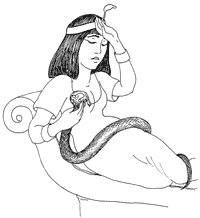STRANGE BUT TRUE- Cleo's end: Cobra likely eclipsed asp

DRAWING BY DEBORAH DERR McCLINTOCK
Q. Queen Cleopatra is undoubtedly history's most famous suicide by snakebite. She had lived fast and died young, having chosen her weapon wisely. How was she a calculating woman to the end? –J. Schiffer
A. "Poor venomous fool, be angry, and dispatch," she implored the serpent, in Shakespeare's Antony and Cleopatra, as she pressed it to her breast. Imprisoned, Cleopatra probably used an Egyptian cobra to make her exit, says Marty Crump in Headless Males Make Great Lovers. Envenomation by a viper would not have left a good-looking corpse but rather one swollen and disfigured. The cobra bite left her more dignified.
"She likely had difficulty breathing but felt little pain or anxiety, lapsed into a coma, and died peacefully and beautifully," Crump writes.
Q. What does a baby's non-stinky poo vs. stinky poo say about breast-feeding vs. formula-feeding? –R. Ford
A. The proteins and fats in mom's milk are more easily digested than those in cow's milk formula, presumably making the natural end product less smelly, says New Scientist magazine. However, breast milk also has a laxative effect, so these babies are often notoriously prolific diaper fillers. Breast milk is in effect made to order for each individual baby, whereas formula has to conform to an average by suiting infants of differing ages, with a baby of one week getting the same nutrients as a child of 12 months. So, much of the fat and protein will be excreted rather than absorbed by the body.
Breast-fed babies absorb almost 100 percent of what they take in– and rarely become constipated– leaving waste that is largely inoffensive H2O. And if you think formulaic diapers are malodorous, just wait until the kid becomes a meat-eating toddler.
Q. Though traveling barely 100 kilometers (62 miles), Italian Attila Pavesi had quite an appetite and so took
along a bowl of soup, a dozen bananas, cinnamon buns, cheese sandwiches, cold spaghetti, and a bucket of water. What was the hungry fellow up to? –L. Armstrong
A. The cyclist was embroiled in a 2 1/2-hour bike race and took along food in a bib draped around his shoulders (An Illustrated History of the Olympics). A human on a bicycle is the most efficient creature on land or in the sea, but energy demands are enormous, says Vincent Mallette in The Science of the Summer Games. A racing cyclist can put out about 250 watts, hour after hour, in a 24-hour race. For a few minutes, bicycling can extract some 40 watts from each kilogram of human muscle.
"Not for nothing did the engineers of the Gossamer Albatross choose a bicycle pedal system for the first plane to achieve man-powered flight– Leonardo's dream was essentially accomplished by pedaling our way to the clouds," Mallette writes.
Q. Imagine you plant a five-pound willow branch in a vat with 200 pounds of soil. Five years later, after regular waterings, the branch has grown into a 165-pound tree. Now how much will the soil weigh? –T. Lawson
A. Still almost 200 pounds! When Flemish physician Jean Baptista van Helmont did this experiment in 1630, he was amazed to discover the soil had lost only a few ounces. So he reasoned the tree material couldn't have come from the soil but from the water instead, says Mahlon Hoagland in Exploring the Way Life Works: The Science of Biology.
He was right in the first conclusion but not entirely in the second, says Oregon State University forest and soils expert Phillip Sollins. Most of a tree's weight comes not from the water but from the carbon of carbon dioxide, right out of "thin air." So when you see a tree, you can think of it as one part water and three parts air, with a sprinkling of the soil nutrients nitrogen, phosphorus, potassium, sulfur, etc. thrown in, all in the presence of that life elixir sunlight.
Send Strange questions to brothers Bill and Rich at [email protected].
#